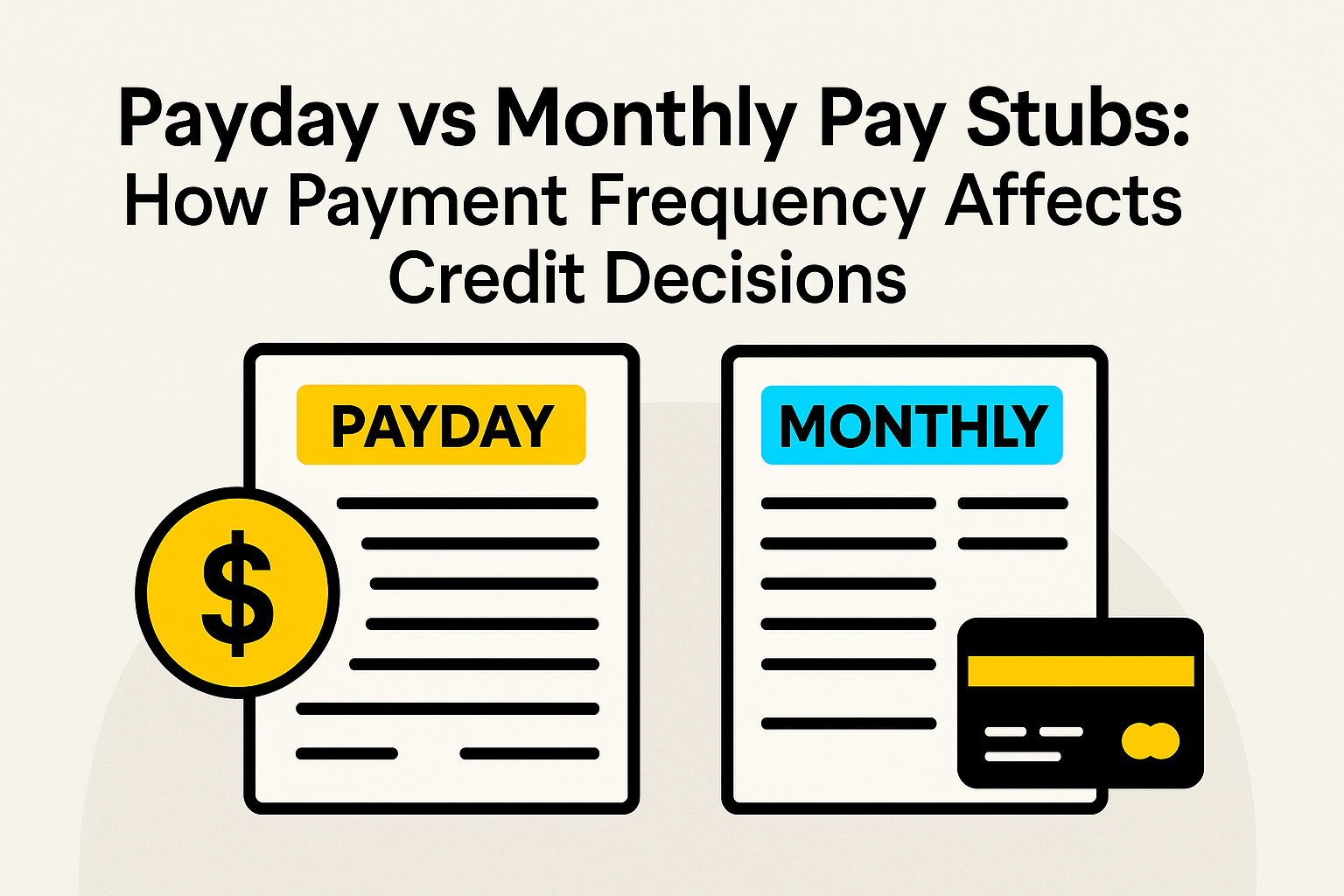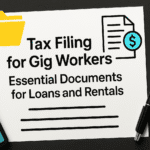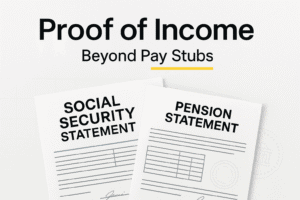Payday vs Monthly Pay Stubs: Why Payment Frequency Matters
By FinancialDocsProvider.com Editorial Team
Published: August 2025 | Last updated: August 2025

Whether your employer pays weekly, biweekly, semimonthly, or monthly, reviewers don’t weigh your income by preference—they convert it to a monthly figure and check for consistency. That’s why understanding Payday vs Monthly Pay Stubs is crucial: the pay frequency you submit affects how quickly underwriters can reconcile totals, spot gaps, and approve your file.
Our role is compliance‑first. We help you format, organize, and package legitimate documents so lenders and landlords can read them fast. We do not fabricate numbers, alter dates, or change counterparties. If a record is wrong, we point you to the official process to correct it, then present the final packet cleanly.
Related Entities & Terms
- Pay stub / payslip (US/UK/CA), pay period: weekly, biweekly, semimonthly, monthly
- DTI (debt‑to‑income), affordability checks, manual underwriting
- W‑2 & 1099‑NEC/1099‑K (US); P60/P45, SA302, PAYE, RTI (UK)
- T4/T4A, CRA Notice of Assessment (NOA), Proof of Income Statement (“Option C”) (CA)
- IRS transcripts, VOE, employer letter, accountant letter
- Open banking data, bank statements, payout histories, merchant processor reports
- CFPB, FTC, IRS (US regulators)
- FCA & GOV.UK (UK regulators and guidance)
- FCAC, CRA (Canadian regulators and revenue agency)
How pay frequency gets normalized in credit decisions
Underwriting systems translate your pay frequency into a monthly amount, then test it against policy (DTI, reserves, employment continuity). Here’s the quick math they use:
| Pay Period | Multiply by | To get monthly income |
|---|---|---|
| Weekly | 52 ÷ 12 = 4.3333 | Weekly gross × 4.3333 |
| Biweekly (every 2 weeks) | 26 ÷ 12 = 2.1667 | Biweekly gross × 2.1667 |
| Semimonthly (twice per month) | 2.0 | Semimonthly gross × 2 |
| Monthly | 1.0 | Monthly gross × 1 |
Because weekly and biweekly pay generate more stubs, reviewers can see overtime and fluctuations more clearly—but they also expect clean labeling and totals that tie out. With monthly payslips, they’ll look for continuity across months, especially if bonuses or commissions are involved. We help by packaging stubs, statements, and summaries in a way that reduces back‑and‑forth.
If you’re comparing document types for a particular application, this guide on pay stub vs. bank statement explains when each is read fastest by reviewers. For deeper math on pay periods, see our biweekly vs semimonthly pay explainer.
Legality Basics (US, UK & Canada): Formatting vs. Falsification
Across markets, the principle is the same: you may improve presentation; you may not change facts. Formatting that increases readability and privacy is generally fine. Altering amounts, dates, or parties is often fraud.
In the United States, official sources carry the most weight. If you need tax‑verified proof, request IRS transcripts via Get Transcript. For consumer credit rights and DTI basics, see the CFPB’s guidance. If a bank statement is wrong, only your bank can fix it; the FTC explains how to dispute errors more broadly in your records.
In the UK, employers issue monthly or four‑weekly payslips under PAYE/RTI. GOV.UK provides clear rules on what a payslip must include—see official payslip guidance. For self‑assessment evidence, HMRC’s SA302 and tax year overview are common.
In Canada, lenders and landlords often accept a CRA Notice of Assessment or a Proof of Income Statement (“Option C”). You can obtain these through the CRA’s online services—start with the CRA’s official pages via Canada.ca (CRA).
What Edits Are Allowed (and Helpful)
Below are examples of edits we routinely make to improve clarity. They’re strictly presentation‑level changes, using information you already have:
- Redactions for privacy: mask account numbers, partial SSN/NINO/SIN, or addresses when policy allows.
- Readability: fix page order, rotate sideways pages, correct bleed‑through scans, add labels (“Week 32” → “Pay period: Aug 1–7”).
- Searchability: run OCR and export to a searchable PDF so underwriters can find dates and totals instantly.
- Packaging: add a cover page with an income summary and a contents list that maps each figure to a source page.
- Reconciliation tables: summarize variable hours/overtime and show how net pay reaches your bank deposits.
- File hygiene: remove stray metadata, compress large scans without losing fidelity.
For deeper background, see our plain‑English guides on pay stub vs paycheck and proof of income for freelancers and gig workers.
What’s Illegal (and Why Reviewers Catch It)
Altering dollar amounts, hours, pay dates, or parties isn’t “editing”—it can be fraud or forgery. Underwriters compare stubs against bank deposits, check employer data via VOE, and use pattern analysis to catch tampering. Submissions with edited facts risk denial, loss of deposit, dealer callbacks, and legal consequences.
If a statement is wrong, don’t “fix” it yourself. Use issuer and regulator processes. We also published a step‑by‑step guide to legally disputing bank statement errors; while you wait for corrections, we can help you package a clean explanation packet.
Use Cases & Mini‑Scenarios
Renters (Weekly/biweekly pay)
Scenario: You’re paid weekly with variable overtime. A property manager asks for the “last 4 pay stubs” and “3 months of bank statements.”
What reviewers expect: clear pay period labeling, a monthly equivalent, and deposits that tie to net pay. Weekly stubs create more pages; make them easy to scan.
How we package it:
- Cover sheet with monthly conversion (weekly × 4.3333) and average net pay.
- Four recent stubs in order, with overtime clearly marked.
- Bank statements with the matching four deposits highlighted and indexed.
- Optional note explaining seasonality (e.g., summer overtime).
Want to stand out? Follow the practical tips in our rental application guide.
UK: Monthly payslips with commission
Scenario: You’re paid monthly in London with base salary + commission. The letting agent wants 3 months of payslips and a bank statement.
Reviewer lens: agencies normalize monthly figures and check for commission volatility. Provide a short note clarifying commission cadence (e.g., quarterly).
- Three payslips with gross, net, tax (PAYE/NI), and YTD clear on page one.
- Bank statement page showing the three net deposits and dates.
- Simple table: base vs commission, plus a 3‑month average.
Canada: Biweekly pay & a car loan
Scenario: You’re paid biweekly in Ontario and applying for auto financing. The dealer requests two recent stubs and a proof of income statement.
- Two latest stubs + monthly equivalent (biweekly × 2.1667) on the cover sheet.
- CRA Proof of Income or NOA attached as tax‑backed proof.
- Bank deposits for the last month matching the two stubs.
Self‑employed packet (US/UK/CA)
Scenario: You invoice clients or receive platform payouts. There are no “pay stubs,” but you still need to pass affordability and DTI checks.
- Year‑to‑date income summary with sources (clients, platforms, marketplace).
- Last 3–6 months of bank statements with deposits labeled by source.
- Latest tax proof (IRS transcript, HMRC SA302, or CRA NOA/Proof of Income).
- Optional accountant letter describing seasonality and continuity.
Our in‑depth guide for contractors and creators is here: proof of income for freelancers.
Small‑business loans (SBA/SME)
Scenario: You’re seeking an SBA microloan or a small line of credit. Reviewers look for a clear relationship between your payroll, sales, and bank inflows.
- P&L summary for the last 12 months (with three lines: revenue, COGS, expenses).
- Business bank statements (3–6 months), with key deposits annotated.
- Owner‑comp documentation: stubs (if on payroll) or draws (if not).
Lost or missing pay stubs
If you can’t locate older stubs, start with employer payroll portals or HR. We also compiled steps to get pay stub duplicates fast. For legitimate formatting help—like combining stubs and statements into one review‑ready PDF—see our financial document services.
About pay stub generators
Some employers don’t issue detailed stubs. If your situation allows, you may create a standardized record of pay information you already possess (never new facts) so reviewers can read it easily. Our free pay stub generator shows what belongs on a stub and how to present it clearly. Use only truthful data from payroll or accounting.
How We Work (Intake → Reconciliation → Formatting → Delivery)
- Intake: You securely upload existing documents (stubs/payslips, bank statements, tax proofs, payout histories) and the reviewer’s checklist.
- Reconciliation: We map gross to net and net to deposits, highlight any gaps, and draft a short variance note you can review.
- Formatting: We fix order and readability, apply OCR, add labels, build a cover page with monthly equivalents, and assemble a single PDF.
- Delivery: You receive a tidy packet + a brief index that references exact pages. We never change amounts, dates, or parties—only formatting and packaging.
Curious about our approach? Read how we work and learn more about our process. For rates, see our pricing.
Quick Compliance Checklist
- Confirm requirements: how many stubs/payslips, which date range, bank statements, and any VOE form?
- Match deposits: ensure stub net pay equals bank deposits for the same period; note any delays or partial weeks.
- Normalize pay frequency: include monthly equivalents on a cover sheet (weekly × 4.3333, biweekly × 2.1667, semimonthly × 2, monthly × 1).
- Label clearly: “Pay period: Aug 1–7, Pay date: Aug 9,” not just “Week 32.”
- Use OCR: export to searchable PDF so reviewers can find names, dates, and totals quickly.
- Protect privacy: redact sensitive IDs where permitted; never hide material facts.
- Explain variance: add a brief note about overtime or commission timing if it affects monthly averages.
- Keep it truthful: never edit amounts, dates, or parties. If a line is wrong, fix it through the issuer.
Common Red Flags That Trigger Manual Review
- Mismatched net‑pay deposits and bank records for the same period
- Inconsistent employer names or EINs across stubs
- Formatting anomalies: uneven fonts, repeated pixel patterns, or misaligned columns
- Gaps in pay periods without an explanation note
- Unusual rounding (e.g., repeating “.00” net pay on variable‑hour jobs)
- “Too perfect” YTD math that doesn’t adjust for unpaid leave or mid‑year hires
- Bonuses or commissions with no trace in deposits
Want to understand how verifiers spot tampering? See our explainer on document verification & fraud detection.
Resources & Further Reading
Official regulator & government links
- IRS – Get Transcript (US)
- CFPB – Debt‑to‑Income Ratio (US)
- GOV.UK – Payslips: what you must get (UK)
- CRA – Canada Revenue Agency (CA)
Related guides on FinancialDocsProvider.com
- Biweekly vs semimonthly: calculate your salary
- Pay stub vs paycheck: what’s the difference?
- Pay stubs vs bank statements for approvals
- Proof of income for freelancers & gig workers
- Fix a bank statement error legally
Company pages
- Need proof of income editing or bank statement formatting?
- Questions about pricing?
- Learn more about our process.
- Ready to start? contact our team.
FAQs
How many pay stubs do lenders or landlords usually require?
It varies by policy. Two to four recent stubs are common for W‑2 employees, plus 2–3 months of bank statements. Self‑employed applicants typically provide tax proof and recent statements. Always follow the exact checklist provided.
How do I convert weekly or biweekly pay to a monthly amount?
Underwriters multiply weekly pay by 4.3333, biweekly by 2.1667, semimonthly by 2, and monthly by 1. Include these conversions on a cover page so reviewers see your monthly equivalent instantly.
Are UK monthly payslips harder to evaluate than weekly ones?
Not necessarily. Monthly payslips are standard in the UK. Provide the last 3 months and ensure net deposits match your bank statement. If commission is paid quarterly, add a short note so the monthly picture is clear.
What do Canadian reviewers prefer—payslips or CRA documents?
Both can work. Many lenders accept recent payslips plus a CRA Notice of Assessment or Proof of Income Statement. Include bank deposits that tie to net pay for the same periods to speed up review.
Can you edit my pay stubs to fix a mistake?
No. We never change amounts, dates, or parties. We can improve formatting and help you package documents clearly. If a figure is wrong, request corrected records from the issuer and then we can organize them professionally.








Add comment